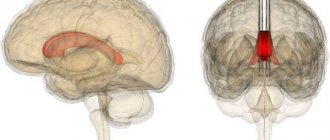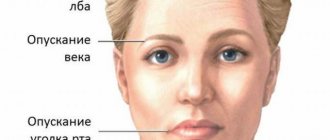Hypertension syndrome develops as a result of a persistent increase in pressure in the cranial cavity. The pathological process is caused by overproduction of cerebrospinal fluid in the ventricles of the brain and impaired cerebral hemodynamics. Hypertension syndrome is a sign of serious diseases and injuries, deadly lesions of the central nervous system: tumors, head injuries, hematomas, encephalitis and meningitis. In the medical literature you can find different names for increased intracranial pressure - cerebrospinal fluid, hydrocephalic syndrome. This disease has an ICD 10 code - G93 and the official name is “Intracranial hypertension”.
Figure 1: Intracranial hypertension with excess amount/pressure of cerebrospinal fluid, e.g. in newborns
Figure 2: hypertension syndrome with a space-occupying formation in the cranium
The brain is well supplied with blood and innervated. This organ has the most developed vascular network. The glandular cells of the cerebral ventricles constantly produce cerebrospinal fluid, circulating between the soft and hard membranes. The processes of formation and outflow of cerebrospinal fluid are interconnected and coordinated. They are regulated by neurohumoral mechanisms and maintain the constancy of the internal environment of the body. The spent liquor is continuously replaced with new one. When its outflow is disrupted and production persists or increases, fluid accumulates in the ventricles of the brain, which leads to increased pressure in the cranial cavity.
In newborns, hypertensive-hydrocephalic syndrome is a common occurrence. The bones of the skull and the ventricular system of the brain experience pressure from the cerebrospinal fluid and increase in volume. This pathology is the result of a congenital dysfunction that is difficult to diagnose due to the child’s inability to talk about his feelings. Most often, the syndrome occurs in premature babies. They develop characteristic external signs - an enlarged fontanelle, open cranial sutures, and a disproportionately large volume of the head. Sick children often cry, do not take the breast, and behave restlessly. They suffer from nausea, fountain vomiting and convulsive muscle contractions. These signs frighten parents and make doctors think about the presence of pathology.
Hypertensive-hydrocephalic syndrome, caused by excessive fluid retention in cerebral structures, is a companion to serious neurological disorders. Liquor accumulates in the ventricles of the brain due to a violation of its outflow and reabsorption. The development of hypertension syndrome is provoked by injuries, viruses, and bacteria. Patients experience cephalalgia, vomiting and dizziness. Hypertension syndrome occurs quite often in the diagnoses of neurologists. It affects both adults and children. The diagnosis of the pathology is alarming, especially in environmentally unfavorable conditions and under constant stress. This dangerous disease often leads to undesirable consequences and even death.
Causes
The immediate cause of hypertension syndrome is stagnation of cerebrospinal fluid, which puts pressure on the brain substance. This polyetiological condition occurs under the influence of a number of unfavorable endogenous and exogenous factors: tumor processes of the brain, hematomas, cysts, vascular hypotonicity, neuroinfection, congenital anomalies of the central nervous system, heredity.
Congenital causes of hypertension syndrome:
- Complicated pregnancy and childbirth,
- Hypoxia of the fetal brain,
- Prematurity,
- Late birth,
- Subarachnoid hemorrhages during childbirth,
- Intrauterine infections
- Congenital brain defects
- Birth injuries
- Long dry period
- Toxicosis and gestosis,
- Onset of diabetes mellitus during pregnancy.
Diseases and special conditions in which intracranial pressure increases:
- intracranial neoplasms, hematomas, etc. – legitimate causes of hypertension syndrome, incl. in adults
Neoplasms: hematomas, tumors, abscesses, cysts that have reached a certain size and have a negative impact on the functioning of the brain;
- Vascular dysfunction - abnormally increased arterial blood flow or obstructed venous outflow;
- Violation of cerebrospinal fluid dynamics;
- Spontaneous causeless increase in blood pressure;
- A heterogeneous group of pathological processes: encephalopathy and cerebral edema of various etiologies, foreign bodies, head injury, infections - tick-borne encephalitis and borreliosis, strokes and their consequences, parasitic diseases of the brain, inflammation of the meninges;
- Systemic diseases - endocrinopathies, osteochondrosis, vegetative-vascular dystonia.
When the volume of structures in the intracranial space becomes critical, intracranial pressure increases. A certain part of the brain begins to shift through natural openings from an area of significant compression to a more loyal one with less pressure. Compression and ischemia occurs of the segments remaining in their natural place. Due to the blockage of the liquor-conducting pathway, further negative consequences occur. Only a qualified specialist, based on the results of a comprehensive diagnostic examination, will be able to determine whether liquor-hypertensive syndrome is acquired or congenital.
Symptoms
Hypertension syndrome is distinguished by a variety of clinical manifestations, which help specialists correctly diagnose and prescribe adequate therapy. The symptoms of the disease in children and adults are almost the same.
Main manifestations of pathology:
- Headache is a nonspecific symptom of the syndrome with which patients most often consult a doctor. This is a clinical sign of various diseases. When intracranial pressure increases, a headache always occurs. The pain is regular, tearing, worsening in the mornings and nights, accompanied by a feeling of heaviness, pulsation and fullness in the head. When a person lies down, the production of cerebrospinal fluid is activated and its absorption is suppressed. The pressure inside the skull increases, which is clinically manifested by cephalgia and other characteristic symptoms. The pain can be so intense that it forces a person to wake up at night. It spreads throughout the head and has no clear localization. The condition of patients returns to normal in the evening, when the outflow of fluid is restored due to the vertical position of the body. Factors that contribute to severe headaches include: stress, excessive physical exertion, prolonged exposure to the sun on an uncovered head. Cephalgia combines the syndrome in different age groups. In severe cases, it is combined with impaired thermoregulation, increased breathing, and the appearance of pain in the heart.
- Dyspeptic symptoms in the form of nausea and vomiting occur in the morning. Mild nausea persists throughout the day. “Cerebral vomiting” is caused by irritation of the rhomboid fossa and the bottom of the 4th ventricle. It is not associated with food intake and does not bring relief. Sudden “fountain vomiting” is accompanied by cephalgia and occurs without previous nausea.
- General weakness, loss of strength, malaise and other signs of asthenia in the body appear after minor psychophysical stress and even at rest. Fatigue can suddenly give way to excitement.
- Patients are nervous, irritable, often restless, and tearful.
- Hypertension syndrome is accompanied by autonomic disorders - tachycardia, hyperhidrosis, insomnia, shortness of breath, muscle weakness. In severe cases, fainting and convulsions are possible.
- Hyperesthesia in this pathology is manifested by itching of the skin and a feeling of crawling throughout the body.
- Sharp jumps in blood pressure are observed against the background of increased heartbeat and sweating.
- Impaired visual function is manifested by decreased visual acuity, veil or fog before the eyes, and diplopia. During ophthalmoscopy, specialists often detect congested optic discs.
- Patients change in appearance - they develop dark circles under their eyes, which cannot be hidden with cosmetics. If the skin around the eyes is stretched, dilated small veins are revealed.
- Decreased sexual desire has varying degrees of severity and often reaches frigidity and impotence.
- Patients with hypertension syndrome are meteodependent . They react sharply to changes in environmental conditions, especially to a decrease in atmospheric pressure.
- Mental disorders arise in the later stages of the process and are manifested by personality changes and a decrease in intelligence.
Craniosacral therapy for elevated ICP
Cranial therapy is considered an effective and efficient method for intracranial hypertension. The chiropractor acts on the bones of the skull, connected with elastic sutures, and brings them into amplitude movement. Session duration is 30-60 minutes. The procedure is similar to gentle and pleasant stroking and rubbing the surface of the head.
The method of alternative medicine can smoothly reduce intracranial hypertension, since the circulation of liquor fluid improves.
The patient also:
- attacks of severe and prolonged headaches stop
- blood flow throughout the body is normalized
- post-traumatic syndromes directly related to the brain are alleviated
The therapy does not cause pain and can also be used for children. Particularly indicated for pathologies caused by obstruction of venous outflow.
Diagnostic procedures
To get rid of hypertension syndrome, it is necessary to identify its cause. For this purpose, the patient should be carefully examined.
Accurate measurement of intracranial pressure can only be done invasively. To do this, a special needle with a pressure gauge is inserted into the skull or spine. Currently, this technique is not carried out due to its complexity and danger for the patient.
To identify the syndrome and make an accurate diagnosis, it is necessary to conduct a number of studies:
- Ophthalmoscopy - detection of dilated and tortuous veins of the fundus. Contrast angiography is used to identify foci of thrombosis and blockage of cerebral vessels.
- Vascular ultrasound - determination of impaired outflow of venous blood from the skull. Neurosonography is an informative and safe method that assesses the structure and size of the brain, allowing timely detection of pathological changes. Ultrasound, reflected from compacted and heterogeneous parts, forms a picture of the state of the brain.
- Tomographic study - obtaining detailed virtual sections of brain tissue, which reveal expanded cavities with cerebrospinal fluid and areas of impaired cerebrospinal fluid dynamics.
- Electroencephalography is a leading method for diagnosing diseases of the nervous system, determining the bioelectrical activity of the brain. With hypertension syndrome, its indicators change significantly. This technique allows you to detect the nature and exact localization of the existing pathology. Hypertensive-hydrocephalic syndrome is characterized by a lack of synchrony in the work of cortical neurons and a diffuse disturbance of their rhythm.
- Echoencephalography is an assessment of the general condition of the brain, its performance, detection of pathological foci and hypertension syndrome using ultrasound.
- Rheoencephalography is a method for determining the elasticity, tension, and symmetry of blood supply to the cerebral vessels. These signs change with hypertension. A rheoencephalogram can confirm the diagnosis.
- X-ray examination of the skull - signs of hypertension syndrome on X-ray: “finger impressions”, thinning of the cranial bones with changes in their shape, osteoporosis, expansion of cranial sutures, increase in head size, smoothing of the relief of the skull bones.
- Cerebrospinal puncture is a reliable research method that is always prescribed to patients for diagnosis and further treatment. This complex procedure is performed in specialized institutions by qualified specialists.
In newborns with suspected hypertension, head circumference is systematically measured and reflexes are checked.
Diagnosis of hypertensive-hydrocephalic syndrome is a rather complex and time-consuming process, which does not always make it possible to establish its presence with 100% probability.
Signs and Symptoms of ICP Problems in Infants
Unfortunately, a newborn baby is not yet able to tell us what is bothering him. That is why we need to be extremely attentive to more than obvious physiological and behavioral signals on his part.
The following symptoms in an infant indicate intracranial pressure :
- refusal of the mother's breast;
- incessant, constant crying;
- frequent turning of the head to the sides;
- restless sleep, hyperexcitability;
- excessive regurgitation, vomiting, nausea;
- tremor;
- uncontrolled movements of the eyeballs;
- increased crying during sudden weather changes;
- passivity and lethargy;
- periodic visual disturbances;
- very rapid head growth;
- general retardation in development: the child walks, speaks, crawls, holds his head later;
- lack of weight gain;
- constant throwing of the head back;
- protrusion of the eyes.
Signs of intracranial pressure in infants:
- prominent large forehead;
- the subcutaneous venous network on the head is visible;
- a strip of white sclera is visible between the upper eyelid and the iris of the eye (when the baby looks down);
- swollen fontanel (normally, it is sunken, slightly convex);
- divergence of the skull bones;
- strabismus (most often on the inside);
- disproportionately large head.
Based on the above signs and symptoms, it is possible to promptly identify increased or decreased intracranial pressure in a child.
Therapeutic measures
Hypertension syndrome is a serious pathology that causes a lot of unpleasant symptoms and is a great danger to humans. Constant pressure on brain structures leads to negative consequences: disruption of the functioning of the central nervous system, decreased intelligence, and disruption of the neurohumoral regulation of internal organs. To avoid such problems, it is necessary to begin treatment immediately after identifying the pathology. To do this, experts prescribe drug therapy to patients and give clinical recommendations:
- Optimize your drinking regime,
- Eat balanced and rationally,
- Take a walk in the fresh air every day,
- Perform special exercises to reduce pressure inside the skull,
- Maintain psycho-emotional peace,
- Avoid aggressive exposure to direct sunlight,
- Contact a chiropractor who, with the help of special hands, will help cope with the disease.
Will these measures be effective only in cases of mild disease?











